Contents:
- Index of Eight Core Industries
- Promoting Pro-Business Policy Critical for India
- Doing Business Rankings
- “Assemble in India for the World”
- Industrial Sector Performance Key to Achieving USD Five Trillion Economy
- Ethical Wealth Creation Key to India Becoming a $ 5 Trillion Economy by 2025
- Some Key Points in the First Advance Estimates of the GDP for FY20
- Role of PSBs in Indian Economy
- Digital Transactions & DBT:
- Creation of FinTech Hub for PSBs: The Public Sector Banking Network (PSBN)
- Insolvency and Bankruptcy Code Improves Resolution Process
- Advantages of Disinvestment – Economic Survey 2020
- Balance of Payment
- India Ranks Third in Number of New Firms Created
- A Novel Health Score: NBFCs
- Nationally Determined Contributions (NDCS)
- All Urban Areas of 35 States/UTs Declared Open Defecation Free
- India Is the Second Largest Emerging Green Bond Market after China
- India Launched Coalition for Disaster Resilient Infrastructure (CDRI)
- India’s Initiative at the International Stage
- Rationalisation of Government Intervention
- India’s Share in Global Exports
- State of Agricultural Mechanisation
- Gross Value Added in Agriculture
- Building Social Infrastructure
- Employment Generation
- MSME Sector
- Expenditure on Social Services
- National Consultation on the review of Beijing +25
INDEX OF EIGHT CORE INDUSTRIES
Why in news?
- The Eight Core Industries comprise 40.27 per cent of the weight of items included in the Index of Industrial Production (IIP).
- The combined Index of Eight Core Industries stood at 133.2 in December, 2019, which increased by 1.3 per cent as compared to the index of December, 2018
- Ministry of commerce and industry releases index of 8 core industries that are, Coal, Crude, Cement, Refinery, Natural gas, Steel, Fertilizer, Electricity
Background
- Definition of IIP: The Index of Industrial Production (IIP) is an index which shows the growth rates in different industry groups of the economy in a stipulated period of time. The IIP index is computed and published by the Central Statistical Organisation (CSO) on a monthly basis.
- Index of Industrial Production (IIP) is a composite indicator that measures the changes in the volume of production of a basket of industrial products during a given period with respect to the volume of production in a chosen base period.
- The base year for the IIP is 2011-12.
PROMOTING PRO BUSINESS POLICY CRITICAL FOR INDIA
- The Economic Survey 2019-20 says India’s aspiration to become a $5 trillion economy depends critically on promoting “pro-business” policy that unleashes the power of competitive markets to generate wealth, on the one hand, and weaning away from “pro-crony” policy that may favour specific private interests, especially powerful incumbents, on the other hand.
- The invisible hand needs to be strengthened by promoting pro-business policies to provide equal opportunities for new entrants, enable fair competition and ease doing business, eliminate policies that undermine markets through government intervention even where it is not necessary, it said.
- It must enable trade for job creation and efficiently scale up the banking sector to be proportionate to the size of the Indian economy, it added.
DOING BUSINESS RANKINGS
- India Jumps up 79 positions in World Bank Doing Business Rankings, Improving From 142 In 2014 To 63 in 2019
- The Goods and Service Tax (GST) and the Insolvency and Bankruptcy Code (IBC) top the list of reforms that have propelled India’s rise in rankings.
- However, it continues to trail in parameters such as Ease of Starting Business (rank 136), Registering Property (rank 154), Paying Taxes (rank 115), and Enforcing Contracts (rank 163).
- The number of procedures required to set up a business in India, for example, has reduced from 13 to 10 over the past ten years.
- As of January 2020, it takes an average of 18 days to set up a business in India, down from 30 days in 2009.
- Although, India has significantly reduced the time and cost of starting a business, a lot more needs to be done.
“ASSEMBLE IN INDIA FOR THE WORLD”
- Integration of “Assemble in India for the World” into ‘Make In India’ Can increase India’s Export Market Share to About 3.5 % by 2025 and 6 % by 2030.
- India should draw a lesson from China’s success in exports, and launch a project to ‘Assemble in India for the world’ that would create 80 million well-paid jobs in the next 10 years, the Economic Survey 2019-20 said.
- The survey suggested that with China-US trade tensions at a high, India should step in to seize opportunities in export manufacturing and create well-paid jobs.
INDUSTRIAL SECTOR PERFORMANCE IS KEY TO ACHIEVING 5 TRILLION $ ECONOMY
- Industrial sector performance in terms of its contribution in Gross Value Added (GVA) improved in 2018-19 over 2017-18.
- However, as per the estimates of Gross Domestic Product by National Statistical Office (NSO), the real GVA of industrial sector grew by 1.6 per cent in first half (H1) (April-September) of 2019-20, as compared to 8.2 per cent in H1 of 2018-19.
ETHICAL WEALTH CREATION KEY TO INDIA BECOMING A $ 5 TRILLION ECONOMY
Levers for furthering Wealth Creation
The Survey identifies several levers for furthering Wealth Creation, which are:
- Entrepreneurship at the grassroots as reflected in new firm creation in India’s districts;
- Promote ‘pro-business’ policies that unleash the power of competitive markets to generate wealth as against ‘pro-crony’ policies that may favour incumbent private interests;
- Eliminate policies that undermine markets through government intervention, even where it is not necessary;
- Integrate ‘Assemble in India’ into ‘Make in India’ to focus on labour intensive exports and thereby create jobs at a large scale;
- Efficiently scale up the banking sector to be proportionate to the size of the Indian economy and track the health of the shadow banking sector;
- Use privatization to foster efficiency. The Survey provides careful evidence that India’s GDP growth estimates can be trusted.
SOME KEY POINTS IN THE FIRST ADVANCE ESTIMATES OF THE GDP FOR FY20
- Uptick in GDP Growth Expected in Second Half of 2019-20; First Advance Estimates PEG Growth for Overall Fiscal at 5 Per Cent
- GDP Growth is expected to grow in The Range of 6.0 to 6.5 Percent in 2020-21, Survey Asks Government to Deliver Expeditiously on Reforms
- GST Collections grew by 4.1 Per Cent for the Centre during April-November, 2019
- Share of Formal Employment Increases from 17.9 Per Cent in 2011-12 To 22.8 Per Cent in 2017-18 Reflecting Formalization in the Economy
- Easing of Crude Prices Lowers Current Account Deficit; Imports Contract More Sharply Than Exports in 1st Half of 2019-20
- Inflation Declines Sharply from 3.2 Per Cent in April 2019 To 2.6 Per Cent in December 2019, Reflecting Weakening of Demand Pressure In the Economy
- Agricultural Growth Shows Modest Revival in First Half of 2019-20
ROLE OF PSBs IN INDIAN ECONOMY
- Public Sector Banks (PSBs) with about 70 per cent of the market share in Indian Banking have an onus of supporting the Indian economy and fostering its economic development.
- For India to march in its goal of becoming a $5trillion economy, PSBs – the dominant banks in our banking system – need to become efficient.
- The Survey expresses that if Indian banks were proportionately large in relation to the size of the Indian economy, India should have at least six banks in the global top 100 than just the current largest PSB- State Bank of India (SBI)-which is the 55th largest bank globally.
DIGITAL TRANSACTIONS & DBT:
- The Economic Survey notes that the growth in digital transactions has been significant. The use of direct benefit transfers has increased exponentially over the last five years, has helped to bring both credit and deposits into the banking system across all geographies
- Key drivers of India’s growth prospects – a) highly favourable demographics – with 35 per cent of its age; (b) a modern and modernising digital infrastructure that encompasses the “JAM” trinity viz., the PMJDY bank account programme, the Aadhaar unique identification programme, and the mobile phone infrastructure; and (c) a uniform indirect taxation system (GST)
- India’s growth path depends on how quickly and productively these growth levers are deployed using a well-developed financial system.
- These growth opportunities position PSBs well to utilize FinTech like Credit analytics using Artificial Intelligence and Machine Learning (AI-ML).
CREATION OF FINTECH HUB FOR PSBs: THE PUBLIC SECTORE BANKING NETWORK (PSBN)
- The Survey proposes that PSBs need to embrace FinTech, which is revolutionizing the global financial landscape.
- FinTech has radically changed the way information is processed by banks.
- The Economic Survey observes that a large proportion of NPAs of Indian banks, especially PSBs, could have been prevented if data and analytics were employed in corporate lending and that a robust credit analytics platform could have easily picked up and provided warning signals besides curbing double-pledging of collateral
- The survey proposes establishment of a GSTN like entity, called PSBN (PSB Network), to use technology to screen and monitor borrowers comprehensively and at length.
- Part-Ownership of PSBs by Employees Through Employee Stock Option Plans Will Reduce Agency Problems
- Financial Inclusion, in Large Part, Happened in August 2014 Through the Pradhan Mantri Jan Dhan Yojana (PMJDY)
INSOLVENCY AND BANKRUPTCY CODE IMPROVES RESOLUTION PROCESS
- The Resolution process in Insolvency and Bankruptcy Code Registers a 4-Fold Decline in Resolution Time
- The IBC proceedings take 340 days on an average compared to 4.3 years earlier and resulted in recovery of 42.5% amount involved compared to 14.5% under SARFAESI Act.
- Capital to Risk Weighted Asset Ratio (CRAR) of Scheduled Commercial Banks (SCBs) has increased from 14.3% to 15.1% between March and September 2019.
- Furthermore, the Survey highlights that CRAR of the sector is at 19.5% in September 2019 as against a statutory requirement of 15 % also acknowledges the stress in the Non-Banking Financial Companies (NBFCs) as GNPA ( Gross Non-Performing Advances) increased from 6.1% in March 2019 to 6.3% in September 2019
ADVANTAGES OF DISINVESTMENT – ECONOMIC SURVEY 2020
- The Economic Survey 2020 affirms that disinvestment improves firm performance and overall productivity, and unlock their potential to create wealth.
- This would have a multiplier effect on other sectors of the economy.
- The Survey suggests that the Government can transfer its stake in the listed CPSEs to a separate corporate entity.
- This entity would be managed by an independent board and would be mandated to divest the Government stake in these CPSEs over a period of time.
- The Survey says that in November, 2019, India launched its biggest privatization drive in more than a decade.
- An “in-principle” approval was accorded to reduce Government of India’s paid-up share capital below 51 percent in select Central Public Sector Enterprises (CPSEs).
BALANCE OF PAYMENT
- The Balance of Payments position improved to USD 433.7 billion by September, 2019 from USD 412.9 billion of forex reserves in March, 2019.
- This is on the back of Current Account Deficit (CAD) narrowing further to 1.5 per cent of GDP in the first half of 2019-20 from 2.1 per cent in 2018-19.
- India’s foreign reserves are comfortably placed at USD 461.2 billion as on 10th January, 2020
- External Debt levels remained low at 20.1 per cent of GDP by the end of September 2019
Merchandise exports
- Petroleum, Oil and Lubricants (POL), precious stones, drug formulations & biologicals, gold and other precious metals continue to be the top exported commodities
- The largest export destinations being United States of America (USA), followed by United Arab Emirates (UAE), China and Hong Kong.
Merchandise imports
Crude petroleum, gold, petroleum products, coal, coke & briquettes constitute top import items. India’s imports continue to be largest from China, followed by USA, UAE and Saudi Arabia in that order.
Global Economic Environment
In sync with an estimated 2.9 percent growth in global output in 2019, global trade is estimated to grow at 1.0 percent after having peaked in 2017 at 5.7 percent.
The slowdown in world trade reflects a confluence of factors, including a slowdown in investment, reduced spending on capital goods and decline in trade of cars and car parts.
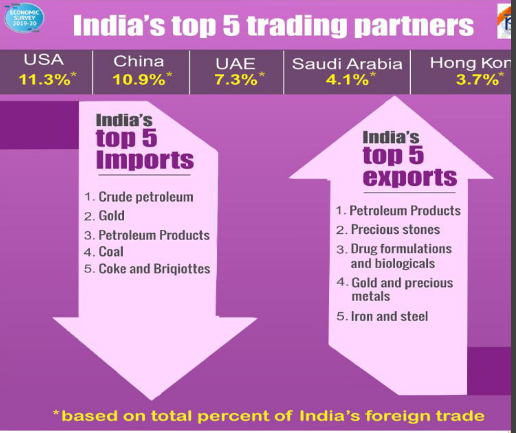
INDIA RANKS THIRD IN NUMBER OF NEW FIRMS CREATED
- The Survey stated that as per World Bank’s Data on Entrepreneurship, it is seen that India ranks third in number of new firms created.
- The same data shows that new firm creation has gone up dramatically in India since 2014.
- While the number of new firms in the formal sector grew at a cumulative annual growth rate of 3.8 per cent from 2006-2014, the growth rate from 2014 to 2018 has been 12.2 per cent.
- As a result, from about 70,000 new firms created in 2014, the number has grown by about 80 per cent to about 1,24,000 new firms in 2018.
A NOVEL HEALTH SCORE: NBFCs
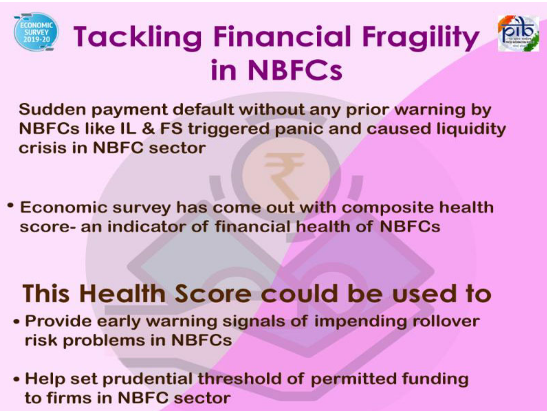
A new diagnostic Health Score developed for the Non-Banking Financial Company (NBFC) and Housing Finance Company (HFC) sectors can help detect early warning signals of impending liquidity problems facing the companies in this sector.
NATIONALLY DETERMINED CONTRIBUTIONS (NDCS)
India Has Strived to Follow a Sustainable Growth Path Aligned With Its Nationally Determined Contributions (NDCS) Under Paris Agreement in Accordance With Principles of Equity and Common but Differentiated Responsibilities
The Economic Survey observes that India is on track to achieve its NDCs. The Survey further highlights the significant leap in India’s renewable energy sector i.e. 83 GW targets being achieved out of aimed target of 175 GW Renewable Energy under one of the World’s largest Renewable Energy expansion program
ALL URBAN AREAS OF 35 STATES/UTs DECLARED OPEN DEFECATION FREE
Further, Swachh Bharat Mission (Urban) was launched in 2014 with twin objectives of ensuring 100 percent scientific solid waste management and making urban India ODF to achieve total environmental improvement. All Urban areas of 35 States/UTs have become ODF and percentage of waste processing rose from around 18 percent to 60 percent.
INDIA IS THE SECOND LARGEST EMERGING GREEN BOND MARKET AFTER CHINA
The Economic Survey highlights India’s decision to revise the National Action Plan on Climate Change (NAPCC) in line with NDCs to make it more comprehensive.
The Survey also lauded the performance of Schemes like UJALA for LED bulb distribution which crossed 360 million.
What is a Green Bond?
A green bond is a bond specifically earmarked to be used for climate and environmental projects. These bonds are typically asset-linked and backed by the issuer’s balance sheet, and are also referred to as climate bonds.
Green Bond Explained
Green bonds are designated bonds intended to encourage sustainability and to support climate-related or other types of special environmental projects. More specifically, green bonds finance projects aimed at energy efficiency, pollution prevention, sustainable agriculture, fishery and forestry, the protection of aquatic and terrestrial ecosystems, clean transportation, sustainable water management and the cultivation of environmentally friendly technologies.
Green bonds come with tax incentives such as tax exemption and tax credits, making them a more attractive investment compared to a comparable taxable bond. This provides a monetary incentive to tackle prominent social issues such as climate change and a movement to renewable sources of energy. To qualify for green bond status, they are often verified by a third party such as the Climate Bond Standard Board, which certifies that the bond will fund projects that include benefits to the environment.
INDIA LAUNCHED COALITION FOR DISASTER RESILIENT INFRASTRUCTURE (CDRI)
Details:
- The Prime Minister of India announced a global Coalition for Disaster Resilient Infrastructure (CDRI), at the UN Climate Action Summit 2019 held in New York City, USA, on September 23, 2019.
- Developed through consultations with more than 35 countries, CDRI envisions enabling measurable reduction in infrastructure losses from disasters, including extreme climate events. CDRI thus aims to enable the achievement of objectives of expanding universal access to basic services and enabling prosperity as enshrined in the Sustainable Development Goals, while also working at the intersection of the Sendai Framework for Disaster Risk Reduction and the Paris Climate Agreement.
INDIA’S INITIATIVE AT THE INTERNATIONAL STAGE
In the Solar Sector, the International Solar Alliance (ISA) has taken up the role of ‘Enabler’ by institutionalizing 30 fellowships from the member countries; of ‘Facilitator’ by getting the lines of credit worth US$2 billion from EXIM Bank of India and US$1.5 billion from Agence Francaise de Development (AFD), France; of an ‘Incubator’
SBI entered the market with an US$650 million Certified Climate Bond. India also joined International Platform on Sustainable Finance (IPSF) in 2019 to scale up the environmentally sustainable investments
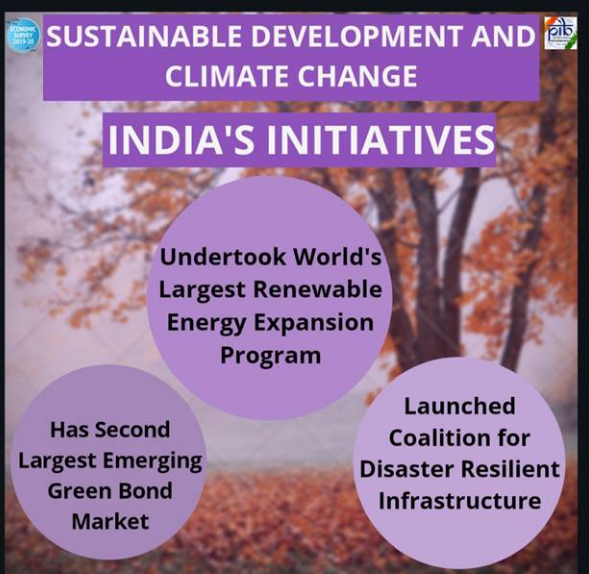
RATIONALISATION OF GOVERNMENT INTERVENTION
The Economic Survey at the very onset says that while there is a case for Government intervention when markets do not function properly, excessive intervention especially when the market can do the job of enhancing citizens welfare perfectly well, stifles economic freedom and creates ‘deadweight loss
Essential Commodities Act, 1955
The Survey describes inter alia, the Essential Commodities Act (ECA) as anachronistic and irrelevant in today’s India as the Act was passed in 1955 in an India worried about famines and shortages. The Survey observes the frequent and unpredictable imposition of blanket stock limits on commodities under the ECA distorts the incentives for creation of storage infrastructure by the private sector, movement up the agricultural value chain and development of a national market for agricultural commodities.
Making Drugs Affordable
Given the important task of ensuring access to essential life saving drugs and to avoid poor households from falling into poverty, Government often has to resort to controlling prices of drugs under Section 3 of the Essential Commodities Act. The Survey expresses concerns over the regulation of drug prices through the National Pharmaceutical Pricing Authority (NPPA) and Drug Price Control Order (DPCO) as it often leads to an increase in the prices of the regulated drug vis-a-vis that of a similar unregulated drug which is counter-productive and leads to a sub-optimal outcome.
Rationalisation of Food Subsidies
The Survey observes that Government policies in the foodgrain markets have led to the emergence of Government as the largest procurer and hoarder of rice and wheat which has led to burgeoning food subsidy burden and inefficiencies in the markets affecting the long run growth of agricultural sector and adversely affecting competition in these markets.
Debt Waivers Disrupt Credit Culture
According to the survey, an analysis of the debt waivers given by States/Centre shows that full waiver beneficiaries consume less, save less, invest less and are less productive after the waiver when compared to the partial beneficiaries.
INDIA’S SHARE IN GLOBAL EXPORTS
India’s Share in World’s Commercial Services Exports Rise to 3.5 Per Cent in 2018: Economic Survey 2019-20
55 percent of the economy and Gross Value Added (GVA) growth, two-thirds of total FDI inflows into India and about 38 percent of the total exports.
- Services Sector Sees 33 Per Cent Jump in Gross FDI Equity Inflows during April – September 2019, Touch Us$17.58 Billion, to Account for Two-Thirds of Total Inflows: Survey
- Shipping Turnaround Time at Ports Halved From 4.67 Days in 2010-11 to 2.48 Days in 2018-19
- 21 Per Cent Year-On-Year Growth for Foreign Tourist Arrivals to India on E-Visas:
STATE OF AGRICULTURAL MECHANISATION
Agriculture Mechanization to Transform Indian Farming Into Commercial Farming, Says Economic Survey
7.9 Per Cent Growth Registered in Livestock Sector During Last Five Years
7 Per Cent Average Annual Growth Rate Registered in Fisheries Sector
5.06 Per Cent Average Annual Growth Rate in Food Processing Sector
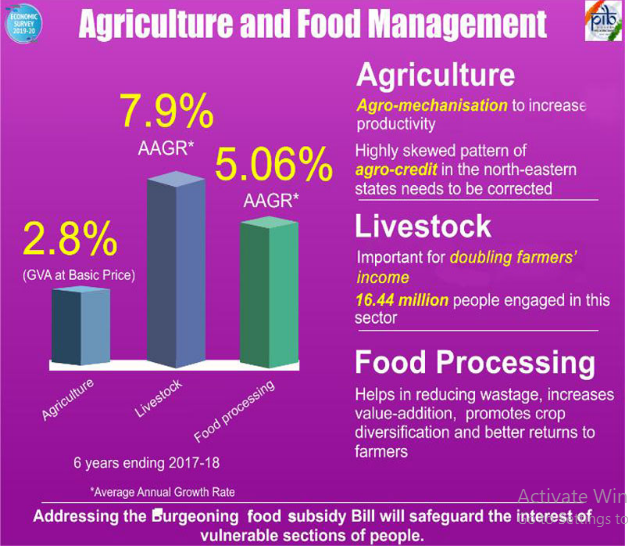
GROSS VALUE ADDED IN AGRICULTURE
Following the natural trajectory of development process and owing to structural changes taking place in economy share of agriculture and allied sectors in Gross Value Added (GVA) of the country at current prices has declined from 18.2 per cent in 2014-15 to 16.5 per cent in 2019-2020
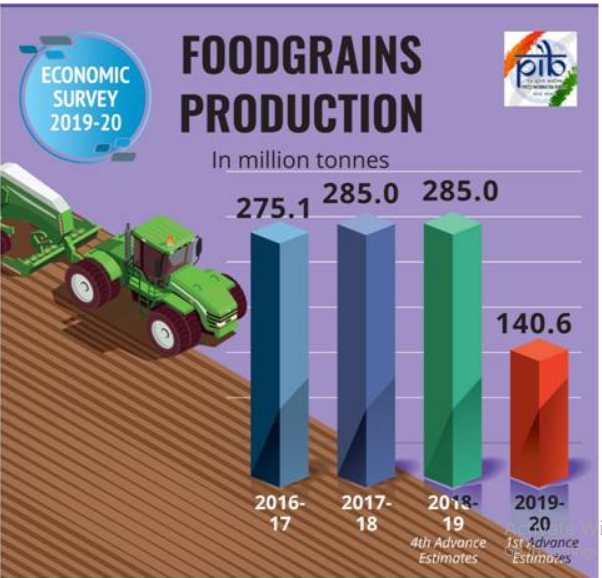
BUILDING SOCIAL INFRASTRUCTURE
Details:
- Samagra Shiksha 2018-19 Launched to Envisage School Education as Continuum from Pre-School to Senior Secondary Level
- Samagra Shiksha 2018-19 has been launched to envisage school education as a continuum from pre-school to senior secondary level. Other initiatives include the expansion of Navodaya Vidyalaya Scheme, Pradhan Mantri Innovative Learning Program (DHRUV), Digital Infrastructure for Knowledge Sharing (DIKSHA) platform and e-content sites like e-pathshala.
- The Pre-Budget Survey also outlines initiatives taken for improving quality of learning and teaching in higher and technical education. These include setting up of Higher Education Financing Agency (HEFA), Schemes like National Educational Alliance for Technology (NEAT), Education Quality Upgradation and Inclusion Programme (EQUIP), PARAMARSH and mega online degree programme SWAYAM 2.0
- “As per Unified District Information System for Education (U-DISE) 2017-18 (provisional), 98.38 per cent of Government elementary schools have girls’ toilet and 96.23 per cent of Government elementary schools have boys’ toilet. 97.13 per cent of Government elementary schools have provision of drinking water facility,
- 28,005 Health & Wellness Centres set up Under Ayushman Bharat as in January 2020
- Mission Indradhanush has vaccinated 3.39 crore children and 87.18 lakh pregnant women of 680 districts across the country till date
- As per the latest National Health Accounts 2016-17, the out of pocket expenditure (OoPE) on health as a percentage of total health expenditure declined from 64.2 per cent in 2013-14 to 58.7 per cent in 2016-17,
- 47.33 Lakh Houses Completed Per Year in 2018-19 Under Pradhan Mantri Awaas Yojana- Gramin
- As per recent NSO survey on Drinking Water, Sanitation, Hygiene and Housing Condition in India 2018, about 76.7 per cent of the households in the rural and about 96.0 per cent in the urban areas had the house of pucca structures
- Over 10 Crore Toilets Built in Rural Areas Under Swachh Bharat Mission- Gramin (SBM-G) Since 2014
- 5.9 lakh villages, 699 districts, and 35 States/UTs have declared themselves Open Defecation Free (ODF). Swachh Survekshan Gramin 2019, India’s largest rural sanitation survey, covered 17,450 villages in 698 districts across India, including 87,250 public places.
- 10 Year Rural Sanitation Strategy (2019-2029) Launched to Focus on Sustaining Sanitation Behaviour Change
EMPLOYMENT GENERATION
Around 2.62 Crore New Jobs Created in Rural and Urban Areas Between 2011-12 and 2017-18 Among Regular Wage/Salaried Employees
The share of regular wage/salaried employees has increased by 5 percentage points from 18 per cent in 2011-12 to 23 per cent in 2017-18
69.03 lakh candidates trained under Pradhan Mantri Kaushal Vikas Yojana as in November 2019
8 per cent increase in regular Employment of Women in 2017-18 over 2011-12
“Remarkably the proportion of women workers in regular wage category have increased by 8 percentage points from 13 per cent in 2011-12 to 21 per cent in 2017-18, Enhancement in paid maternity leave from 12 weeks to 26 weeks and provisions for mandatory crèche facility in establishments with 50 or more employees, among others.
The Survey also outlines the initiatives that have been implemented for women empowerment across the country, such as Mahila Shakti Kendra Scheme, Women Helpline Scheme, establishment of One Stop Centres etc.
MSME SECTOR
The Prime Minister of India, Shri Narendra Modi on 2nd November 2018, announced key reforms for faster growth of this sector. The initiatives and the status of these initiatives are :
(i) In-principle approval for loans up to Rs.1 crore within 59 minutes through on-line portal. 1,59,422 number of loans have been sanctioned involving Rs.49,330 crore. Of this, Rs.37,106 crore have been disbursed upto October 2019.
(ii) Interest subvention of 2 per cent for all GST registered MSMEs on incremental credit upto Rs.1 crore. SIDBI has received and settled claim of Rs.18 crore from 43 banks/NBFCs for the period from November 2018 to March 2019.
(iii) All companies with a turnover more than Rs.500 crore to be mandatorily on TReDS platform to enable entrepreneurs to access credit from banks. So far 329 companies have registered themselves on the TReDS portal.
(iv) All Central Public Sector Undertakings (CPSUs) to compulsorily procure at least 25 per cent of their total purchases from MSMEs. CPSUs have procured goods and services worth Rs. 15,936.39 crore from 59,903 MSMEs.
(v) Out of the 25 per cent procurement mandated from MSMEs 3 per cent is reserved for women entrepreneurs. During 2019-20, procurement has been done from 1,471 women owned MSMEs to the tune of Rs.242.12 crore.
(vi) All CPSUs must mandatorily procure through GeM portal. 258 CPSUs/CPSVs have been on boarded/registered on the GeM portal and a total of 57,351 MSME sellers and service providers have been registered on the portal.
(vii) 20 Technology Centres (TCs) and 100 Extension Centres (ECs) to be established at the cost of Rs.6,000 crore. Rs.99.30 crore have been released for setting up of these TCs and ECs. Ten more ECs have been planned in FY 2019-20.
(viii) The Government to bear 70 per cent of the cost for establishing pharma cluster. Four districts of Solan, Indore, Aurangabad and Pune have been selected for pharma clusters and developing of common facilities.
(ix) Returns under eight labour laws and 10 Union Regulations to be filed once a year.
(x) Establishments to be visited by an Inspector will be decided through a computerized random allotment. 3,080 inspections have been conducted and all inspection reports have been uploaded on Shram Suvidha portal.
EXPENDITURE ON SOCIAL SERVICES
Expenditure on Social Services Increased by 1.5 Percentage Points as Proportion of GDP between 2014-15 and 2019-20
The expenditure on social services by the Centre and States increased from 7.68 lakh crore in 2014-15 to 15.79 lakh crore in 2019-20 (Budget Estimate). As a proportion of Gross Domestic Product (GDP)
Similarly, expenditure on health increased from 1.2 per cent to 1.6 per cent during the same period as percentage of GDP
1.34 Per Cent Average Annual HDI Growth Makes India One of the Fastest Improving Countries
India’s rank in the Human Development Index (HDI) improved to 129 in 2018 from 130 in 2017, reaching a value of 0.647. With 1.34 per cent average annual HDI growth, India is among the fastest improving countries. Among its BRICS peers, India is ahead of China (0.95), South Africa (0.78), Russian Federation (0.69) and Brazil (0.59).
Expenditure on ‘Education and Health’ As Percentage of GDP Increased From 4 To 4.7 Per Cent Between 2014-15 And 2019-20
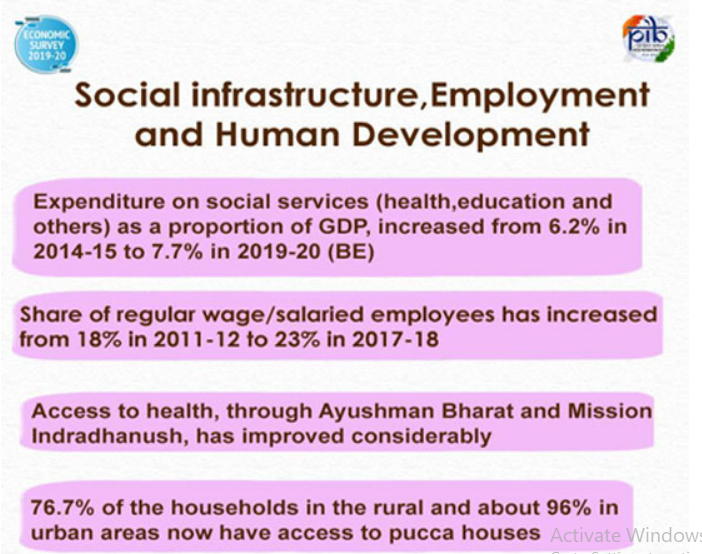
NATIONAL CONSULTATION ON THE REVIEW OF BEIJING +25
To mark of 25 years of the adoption of Beijing Platform for Action, Ministry of Women & Child Development (MWCD), the National Commission for Women (NCW) and UN Women organized a National Consultation on the Review of Beijing+25, to galvanize all stakeholders to implement actions that remove the most conspicuous barriers to gender equality.
The 1995 Fourth World Conference on Women, held in Beijing, was one of the largest ever gatherings of the United Nations, and a critical turning point in the world’s focus on gender equality and the empowerment of women




